Fusion of Airborne, SLAM-Based, and iPhone LiDAR for Accurate Forest Road Mapping in Harvesting Areas
Abstract
1. Introduction
2. Materials and Methods
2.1. Study Area Description
2.2. Aerial Laser Scanning Acquisition Data and Processing
2.3. Mobile Laser Scanning Data Collection and Preprocess
2.4. iPhone-Based Data Collection and Preprocessing
2.5. Data Fusion of All Point Clouds
2.6. Data Collection Validation
3. Results
3.1. Comparative Analysis of Point Cloud Data
3.1.1. Aerial Laser Scanning Data Generation
3.1.2. Comparison of Measurement Methods for Forest Road DEMs
3.1.3. Sensor Performance Analysis for Forest Road Cross Sections
3.1.4. Sensor Performance Analysis Across Different Terrain Conditions
3.2. Accuracy Analysis of Forest Road DEMs Based on GNSS RTK Measurements
4. Discussion
5. Conclusions
Author Contributions
Funding
Data Availability Statement
Conflicts of Interest
Abbreviations
| LiDAR | Light Detection and Ranging |
| SLAM | Simultaneous Localization and Mapping |
| HPLS | Handheld Laser Scanner |
| DEM | Digital Elevation Model |
| DSM | Digital Surface Model |
| TDOM | True Digital Orthophoto Map |
| ALS | Airborne Laser Scanner |
| TLS | Terrestrial Laser Scanning |
| UAV | Unmanned Aerial Vehicle |
| GNSS | Global Navigation Satellite System |
| RTK | Real-Time Kinematic |
| GCP | Ground Control Point |
| IDW | Inverse Distance Weighting |
| CHM | Canopy Height Model |
| MAE | Mean Absolute Error |
| RMSE | Root Mean Square Error |
Appendix A
| Parameter | Equipment | ||
|---|---|---|---|
| DJI Zenmuse L2 LiDAR Sensor | Leica BLK2GO HPLS | iPhone 13 Pro Max LiDAR | |
| Manufacturer | DJI | Leica Geosystems | Apple |
| Sensor Type | Livox LiDAR module (non-repetitive scanning) | Multi-line (High-Speed) Pulsed Laser Scanner | VCSEL-based ToF LiDAR |
| Laser Class | Class 1 (Eye-safe) | Class 1 (Eye-safe) | Class 1 (Eye-safe) |
| Wavelength | 905 nm | 830 nm | ~940 nm |
| Range | ≤450 m (reflectivity-dependent) | Up to 25 m | Up to ~5 m (typical use) |
| Accuracy | ±5 cm @ 150 m | 10–20 mm @ 10 m | ~±1–2 cm (short-range, under ideal conditions) |
| Field of View | 70.4° × 77.2° (FOV of scanner) | 360° horizontal, ~270° vertical | ~120° horizontal |
| Scan Rate/Points per Second (pts/s) | Max 240,000 pts/s | Up to 420,000 pts/s | ~600,000 pts/s (raw capture) |
| Measurement Principle | Hybrid Time-of-Flight with APD receiver | Direct time-of-flight pulsed laser scanning | Indirect ToF (modulated VCSEL) |
| Inertial Measurement Unit (IMU) | Integrated high-accuracy IMU | High-grade SLAM IMU for 3D path tracking | Built-in phone IMU (consumer-grade) |
| SLAM Capability | Supported (RTK/IMU assisted) | Yes (real-time 3D mapping) | Software-based, limited (ARKit) |
| Weight | ~905 g (sensor only) | ~775 g | Entire phone ~238 g |
| Power Source | Powered by drone | Internal rechargeable battery (~45 min runtime) | Phone battery |
| Primary Use Case | Aerial LiDAR mapping with drone integration | Mobile indoor/outdoor mapping, construction | AR apps, room scanning, small-scale modeling |
| Data Output | Point cloud (LAS), intensity, GPS/IMU data | Point cloud (E57, LAS, etc.) | Depth map (ARKit), .USDZ, or .OBJ via apps |
References
- Boston, K. The Potential Effects of Forest Roads on the Environment and Mitigating their Impacts. Curr. For. Rep. 2016, 2, 215–222. [Google Scholar] [CrossRef]
- Dadrasjavan, F.; Zarrinpanjeh, N.; Ameri, A. Automatic Crack Detection of Road Pavement Based on Aerial UAV Imagery. preprint 2019, 2019070009 (v1). [Google Scholar] [CrossRef]
- Dodson, E.M. Challenges in Forest Road Maintenance in North America. Croat. J. For. Eng. 2021, 42, 107–116. [Google Scholar] [CrossRef]
- Kweon, H.; Seo, J.I.; Lee, J.-W. Assessing the Applicability of Mobile Laser Scanning for Mapping Forest Roads in the Republic of Korea. Remote Sens. 2020, 12, 1502. [Google Scholar] [CrossRef]
- Marchi, E.; Chung, W.; Visser, R.; Abbas, D.; Nordfjell, T.; Mederski, P.S.; McEwan, A.; Brink, M.; Laschi, A. Sustainable Forest Operations (SFO): A new paradigm in a changing world and climate. Sci. Total Environ. 2018, 634, 1385–1397. [Google Scholar] [CrossRef]
- Picchio, R.; Latterini, F.; Mederski, P.S.; Tocci, D.; Venanzi, R.; Stefanoni, W.; Pari, L. Applications of GIS-Based Software to Improve the Sustainability of a Forwarding Operation in Central Italy. Sustainability 2020, 12, 5716. [Google Scholar] [CrossRef]
- Tan, Y.; Li, Y. UAV Photogrammetry-Based 3D Road Distress Detection. ISPRS Int. J. Geo-Inf. 2019, 8, 409. [Google Scholar] [CrossRef]
- Toscani, P.; Sekot, W.; Holzleitner, F. Forest Roads from the Perspective of Managerial Accounting—Empirical Evidence from Austria. Forests 2020, 11, 378. [Google Scholar] [CrossRef]
- Xu, Q.; Li, M.; Jiang, X.; Zhang, Z.; Jiao, J.; Jian, J.; Li, J.; Yan, X.; Liang, Y.; Chen, T.; et al. Response of rill erosion to rainfall types and maintenance on the Loess Plateau: Implications for road erosion control. Catena 2022, 219, 106642. [Google Scholar] [CrossRef]
- Korpinen, O.-J.; Aalto, M.; Venäläinen, P.; Ranta, T. Impacts of a High-Capacity Truck Transportation System on the Economy and Traffic Intensity of Pulpwood Supply in Southeast Finland. Croat. J. For. Eng. 2019, 40, 89–105. [Google Scholar]
- Siafali, E.; Tsioras, P.A. Surface Deformation Monitoring in Forest Road Networks: A High Precision UAV Real-Time Kinematic Approach. In Proceedings of the Research and Practice in Forest Ecology, Kórnik, Poland, 8–12 May 2024; p. 181. [Google Scholar]
- Heinimann, H.R. Forest Road Network and Transportation Engineering–State and Perspectives. Croat. J. For. Eng. 2017, 38, 155–173. [Google Scholar]
- Stefanović, B.; Stojnić, D.; Danilović, M. Multi-criteria forest road network planning in fire-prone environment: A case study in Serbia. J. Environ. Plan. Manag. 2016, 59, 911–926. [Google Scholar] [CrossRef]
- Latterini, F.; Dyderski, M.K.; Horodecki, P.; Picchio, R.; Venanzi, R.; Lapin, K.; Jagodziński, A.M. The Effects of Forest Operations and Silvicultural Treatments on Litter Decomposition Rate: A Meta-analysis. Curr. For. Rep. 2023, 9, 276–290. [Google Scholar] [CrossRef]
- Siafali, E.; Tsioras, P.A. An Innovative Approach to Surface Deformation Estimation in Forest Road and Trail Networks Using Unmanned Aerial Vehicle Real-Time Kinematic-Derived Data for Monitoring and Maintenance. Forests 2024, 15, 212. [Google Scholar] [CrossRef]
- Marion, Y.F.; Eagleston, H.; Burroughs, K. A review and synthesis of recreation ecology research findings on visitor impacts to wilderness and protected natural areas. J. For. 2016, 114, 352–362. [Google Scholar] [CrossRef]
- Leung, Y.F.; Newburger, T.; Jones, M.; Kuhn, B.; Woiderski, B. Developing a monitoring protocol for visitor-created informal trails in Yosemite National Park, USA. Environ. Manag. 2011, 47, 93–106. [Google Scholar] [CrossRef]
- Ramos-Scharrón, C.E.; Alicea-Díaz, E.E.; Figueroa-Sánchez, Y.A.; Viqueira-Ríos, R. Road cutslope erosion and control treatments in an actively-cultivated tropical montane setting. Catena 2022, 209, 105814. [Google Scholar] [CrossRef]
- Acuna, M. Timber and Biomass Transport Optimization: A Review of Planning Issues, Solution Techniques and Decision Support Tools. Croat. J. For. Eng. 2017, 38, 279–290. [Google Scholar]
- Siafali, E.; Tsioras, P.A. Uav-Enabled Deformation Classification and Earthworks Assessment For Sustainable Wood Extraction Management. In Proceedings of the FORMEC 2024: Timber Harvesting: The Reality of Offsetting the Needs of Industry Against Those of the Environment, Gdańsk, Poland, 11–14 June 2024; p. 167. [Google Scholar]
- Siafali, E. Implementation of Innovative Technologies in Surveying, Projecting, and Managing Hiking Trails. Ph.D. Thesis, Aristotle University of Thessaloniki, Thessaloniki, Greece, 2023. [Google Scholar]
- Mederski, P.S.; Borz, S.A.; Đuka, A.; Lazdiņš, A. Challenges in Forestry and Forest Engineering: Case Studies from Four Countries in East Europe. Croat. J. For. Eng. 2021, 42, 117–134. [Google Scholar] [CrossRef]
- Malladi, K.T.; Quirion-Blais, O.; Sowlati, T. Development of a decision support tool for optimizing the short-term logistics of forest-based biomass. Appl. Energy 2018, 216, 662–677. [Google Scholar] [CrossRef]
- Karagiannis, E. Evaluation of road opening up in Greek forests. In Scientific Yearbook; School of Forestry and Natural Environment: Thessaloniki, Greece, 2008; pp. 714–727. [Google Scholar]
- Mikita, T.; Krausková, D.; Hrůza, P.; Cibulka, M.; Patočka, Z. Forest Road Wearing Course Damage Assessment Possibilities with Different Types of Laser Scanning Methods including New iPhone LiDAR Scanning Apps. Forests 2022, 13, 1763. [Google Scholar] [CrossRef]
- Talbot, B.; Astrup, R. A review of sensors, sensor-platforms and methods used in 3D modelling of soil displacement after timber harvesting. Croat. J. For. Eng. 2021, 42, 149–164. [Google Scholar] [CrossRef]
- Akgul, M.; Yurtseven, H.; Akburak, S.; Demir, M.; Cigizoglu, H.K.; Ozturk, T.; Eksi, M.; Akay, A.O. Short term moniterning of forest road pavement degradation using terrestrial laser scanning. Measurement 2017, 103, 283–293. [Google Scholar] [CrossRef]
- Akgul, M.; Akburak, S.; Yurtseven, H.; Akay, A.O.; Cigizoglu, H.K.; Demir, M.; Ozturk, T.; Eksi, M. Potential Impacts of Weather and Traffic Conditions on Road Surface Performance in Terms of Forest Operations Continuity. Appl. Ecol. Environ. Res. 2019, 17, 2533–2550. [Google Scholar] [CrossRef]
- Mercier, P.; Aas, G.; Dengler, J. Effects of skid trails on understory vegetation in forests: A case study from Northern Bavaria (Germany). For. Ecol. Manag. 2019, 453, 117579. [Google Scholar] [CrossRef]
- Correia, P.; Oliveira, H. Automatic Road Crack Segmentation Using Entropy and Image Dynamic Thresholding. In Proceedings of the European Signal Processing Conference (EUSIPCO 2009), Glasgow, UK, 24–28 August 2009. [Google Scholar]
- Sadeghi, S.; Ahmad, S.; Tsioras, P.A. Effects of traffic intensity and travel speed on forest soil disturbance at different soil moisture conditions. Int. J. For. Eng. 2022, 33, 146–154. [Google Scholar] [CrossRef]
- Jourgholami, M.; Hansson, L.J.; Högbom, L.; Jourgholami, M.; Laschi, A. Strategies to Mitigate the Effects of Soil Physical Disturbances Caused by Forest Machinery: A Comprehensive Review. Curr. For. Rep. 2022, 8, 20–37. [Google Scholar] [CrossRef]
- Jourgholami, M.; Majnounain, B.; Etehadi Abari, M. Effects of tree-length timber skidding on soil compaction in the skid trail in Hyrcanian forests. For. Syst. 2014, 23, 288–293. [Google Scholar] [CrossRef]
- Marchi, R.; Spinelli, R.; Verani, S.; Venanzi, R.; Certini, G.E.; Picchio, R. Environmental impact assessment of different logging methods in pine forests thinning. Ecol. Eng. 2014, 70, 429–436. [Google Scholar] [CrossRef]
- Solgi, A.; Naghdi, R.; Zenner, E.K.; Hemmati, V.; Behjou, F.K.; Masumian, A. Evaluating the Effectiveness of Mulching for Reducing Soil Erosion in Cut Slope and Fill Slope of Forest Roads in Hyrcanian Forests. Croat. J. For. Eng. 2021, 42, 259–268. [Google Scholar] [CrossRef]
- Gibson, K.S.; Neher, D.A.; Johnson, N.C.; Parmenter, R.R.; Antoninka, A.J. Heavy Logging Machinery Impacts Soil Physical Properties More than Nematode Communities. Forests 2023, 14, 1205. [Google Scholar] [CrossRef]
- Picchio, R.; Mederski, P.S.; Tavankar, F. How and How Much, Do Harvesting Activities Affect Forest Soil, Regeneration and Stands? Curr. For. Rep. 2020, 6, 115–128. [Google Scholar] [CrossRef]
- Sherba, J.; Blesius, L.; Davis, J. Object-Based Classification of Abandoned Logging Roads under Heavy Canopy Using LiDAR. Remote Sens. 2014, 6, 4043–4060. [Google Scholar] [CrossRef]
- Waga, K.; Tompalski, P.; Coops, N.C.; White, J.C.; Wulder, M.A.; Malinen, J.; Tokola, T. Forest Road Status Assessment Using Airborne Laser Scanning. For. Sci. 2020, 66, 501–508. [Google Scholar] [CrossRef]
- Kiss, K.; Malinen, J.; Tokola, T. Forest road quality control using ALS data. Can. J. For. Res. 2015, 45, 1636–1642. [Google Scholar] [CrossRef]
- Luetzenburg, G.; Kroon, A.; Bjørk, A.A. Evaluation of the Apple iPhone 12 Pro LiDAR for an Application in Geosciences. Sci. Rep. 2021, 11, 22221. [Google Scholar] [CrossRef]
- Aldea, S.E.; Le Hégarat-Mascle, S. Robust crack detection for unmanned aerial vehicles inspection in an 409 a-contrario decision framework. J. Electron. Imaging 2015, 24, 061119. [Google Scholar] [CrossRef]
- Grandsaert, P.J. Integrating Pavement Crack Detection and Analysis Using Autonomous Unmanned Aerial Vehicle Imagery; Air Force Institute of Technology: Greene, OH, USA, 2015.
- Sankarasrinivasan, S.; Balasubramanian, E.; Karthik, K.; Chandrasekar, U.; Gupta, R.S. Health Monitoring of Civil Structures with Integrated UAV and Image Processing System. In Proceedings of the 11th International Multi-Conference on Information Processing, Bangalore, India, 21–23 August 2015; pp. 508–515. [Google Scholar]
- Alfio, V.S.; Costantino, D.; Pepe, M. Influence of Image TIFF Format and JPEG Compression Level in the Accuracy of the 3D Model and Quality of the Orthophoto in UAV Photogrammetry. J. Imaging 2020, 6, 30. [Google Scholar] [CrossRef]
- Manajitprasert, S.; Tripathi, N.K.; Arunplod, S. Three-Dimensional (3D) Modeling of Cultural Heritage Site Using UAV Imagery: A Case Study of the Pagodas in Wat Maha That, Thailand. Appl. Sci. 2019, 9, 3640. [Google Scholar] [CrossRef]
- Kim, I.; Seo, J.; Woo, H.; Choi, B. Assessing Rutting and Soil Compaction Caused by Wood Extraction Using Traditional and Remote Sensing Methods. Forests 2025, 16, 86. [Google Scholar] [CrossRef]
- Kweon, H. Comparisons of Estimated nCircuity Factor of Forest Roads with Different Vertical Heights in Mountainous Areas, Republic of Korea. Forests 2019, 10, 1147. [Google Scholar] [CrossRef]
- Hoseini, M.; Puliti, S.; Hoffmann, S.; Astrup, R. Pothole detection in the woods: A deep learning approach for forest road surface monitoring with dashcams. Int. J. For. Eng. 2024, 35, 303–312. [Google Scholar] [CrossRef]
- Biçici, S.; Zeybek, M. An approach for the automated extraction of road surface distress from a UAV-derived point cloud. Autom. Constr. 2021, 122, 103475. [Google Scholar] [CrossRef]
- Baiocchi, V.; Del Pizzo, S.; Monti, F.; Pugliano, G.; Onori, M.; Robustelli, U.; Troisi, S.; Vatore, F.; León Trujillo, F.J. Solutions and limitations of the geomatic survey of an archaeological site in hard to access areas with a latest generation smartphone: The example of the Intihuatana stone in Machu Picchu (Peru). Acta IMEKO 2022, 11, 8. [Google Scholar] [CrossRef]
- Díaz-Vilariño, L.; Tran, H.; Frías, E.; Balado, J.; Khoshelham, K. 3D mapping of indoor and outdoor environments using Apple smart devices. Int. Arch. Photogramm. Remote Sens. Spat. Inf. Sci. 2022, XLIII-B4-2022, 303–308. [Google Scholar] [CrossRef]
- Zhu, L.; Zhang, H.; Li, X.; Zhu, F.; Liu, Y. GNSS Timing Performance Assessment and Results Analysis. Sensors 2022, 22, 2486. [Google Scholar] [CrossRef]
- Forkuo, G.O.; Borz, S.A. Accuracy and inter-cloud precision of low-cost mobile LiDAR technology in estimating soil disturbance in forest operations. Front. For. Glob. Change 2023, 6, 1224575. [Google Scholar] [CrossRef]
- Nakagomi, H.; Fuse, Y.; Nagata, Y.; Hosaka, H.; Miyamoto, H.; Yokozuka, M.; Kamimura, A.; Watanabe, H.; Tanzawa, T.; Kotani, S. Forest road surface detection using LiDAR-SLAM and U-Net. In Proceedings of the 2021 IEEE/SICE International Symposium on System Integration, SII 2021, Iwaki, Japan, 11–14 January 2021; pp. 727–732. [Google Scholar]
- Tomaštík, J.; Tomaštík, J.; Saloň, Š.; Piroh, R. Horizontal accuracy and applicability of smartphone GNSS positioning in forests. For. Int. J. For. Res. 2016, 90, 187–198. [Google Scholar] [CrossRef]
- Kukko, A.; Kaijaluoto, R.; Kaartinen, H.; Lehtola, V.V.; Jaakkola, A.; Hyyppä, J. Graph SLAM correction for single scanner MLS forest data under boreal forest canopy. ISPRS J. Photogramm. Remote Sens. 2017, 132, 199–209. [Google Scholar] [CrossRef]
- Shao, J.; Zhang, W.; Mellado, N.; Wang, N.; Jin, S.; Cai, S.; Luo, L.; Lejemble, T.; Yan, G. SLAM-aided forest plot mapping combining terrestrial and mobile laser scanning. ISPRS J. Photogramm. Remote Sens. 2020, 163, 214–230. [Google Scholar] [CrossRef]
- Zhou, T.; Zhao, C.; Wingren, C.P.; Fei, S.; Habib, A. Forest feature LiDAR SLAM (F2-LSLAM) for backpack systems. ISPRS J. Photogramm. Remote Sens. 2024, 212, 96–121. [Google Scholar] [CrossRef]
- Pierzchała, M.; Giguère, P.; Astrup, R. Mapping forests using an unmanned ground vehicle with 3D LiDAR and graph-SLAM. Comput. Electron. Agric. 2018, 145, 217–225. [Google Scholar] [CrossRef]
- Azizi, Z.; Najafi, A.; Sadeghian, S. Forest Road Detection Using LiDAR Data. J. For. Res. 2014, 25, 975–980. [Google Scholar] [CrossRef]
- Türk, Y.; Özçelik, V.; Akduman, E. Capabilities of using UAVs and close range photogrammetry to determine short-term soil losses in forest road cut slopes in semi-arid mountainous areas. Environ. Monit. Assess. 2024, 196, 149. [Google Scholar] [CrossRef] [PubMed]
- Hruza, T.; Tyagur, N.; Krejza, Z.; Cibulka, M.; Procházková, A.; Patocka, Z. Detecting Forest Road Wearing Course Damage Using Different Methods of Remote Sensing. Remote Sens. 2018, 10, 492. [Google Scholar] [CrossRef]
- Buján, S.; Guerra-Hernández, J.; González-Ferreiro, E.; Miranda, D. Forest Road Detection Using LiDAR Data and Hybrid Classification. Remote Sens. 2021, 13, 393. [Google Scholar] [CrossRef]
- Yadav, Y.; Kushwaha, S.K.P.; Mokros, M.; Chudá, J.; Pondelík, M. Intergration of iPhone LiDAR with quadcopter and fixed wing UAV Photogrammetry for the forest applications. Int. Arch. Photogramm. Remote Sens. Spat. Inf. Sci. 2023, XLVIII-1/W3-2023, 213–218. [Google Scholar] [CrossRef]
- Khanal, M.; Hasan, M.; Sterbentz, N.; Johnson, R.; Weatherly, J. Accuracy Comparison of Aerial Lidar, Mobile-Terrestrial Lidar, and UAV Photogrammetric Capture Data Elevations over Different Terrain Types. Infrastructures 2020, 5, 65. [Google Scholar] [CrossRef]
- Qian, C.; Liu, H.; Tang, J.; Chen, Y.; Kaartinen, H.; Kukko, A.; Zhu, L.; Liang, X.; Chen, L.; Hyyppä, J. An Integrated GNSS/INS/LiDAR-SLAM Positioning Method for Highly Accurate Forest Stem Mapping. Remote Sens. 2016, 9, 3. [Google Scholar] [CrossRef]
- Zhou, R.; Sun, H.; Ma, K.; Tang, J.; Chen, S.; Fu, L.; Liu, Q. Improving Estimation of Tree Parameters by Fusing ALS and TLS Point Cloud Data Based on Canopy Gap Shape Feature Points. Drones 2023, 7, 524. [Google Scholar] [CrossRef]
- Muhojoki, J.; Tavi, D.; Hyyppä, E.; Lehtomäki, M.; Faitli, T.; Kaartinen, H.; Kukko, A.; Hakala, T.; Hyyppä, J. Benchmarking Under- and Above-Canopy Laser Scanning Solutions for Deriving Stem Curve and Volume in Easy and Difficult Boreal Forest Conditions. Remote Sens. 2024, 16, 1721. [Google Scholar] [CrossRef]
- Chen, J.; Zhao, D.; Zheng, Z.; Xu, C.; Pang, Y.; Zeng, Y. A clustering-based automatic registration of UAV and terrestrial LiDAR forest point clouds. Comput. Electron. Agric. 2024, 217, 108648. [Google Scholar] [CrossRef]
- Bugday, E.; Akay, A.E. Determination of the Forest Road Alignment in Landslide-Prone Areas based on Landslide Susceptibility Map Generated by Machine Learning Approaches. In Proceedings of the COFE-FETEC 2023—Forest Operations: A Tool for Forest Management, Flagstaff, AZ, USA, 23–25 May 2023. [Google Scholar]
- Balenović, I.; Liang, X.; Jurjević, L.; Hyyppä, J.; Seletković, A.; Kukko, A. Hand-Held Personal Laser Scanning: Current Status and Perspectives for Forest Inventory Application. Croat. J. For. Eng. 2021, 42, 165–183. [Google Scholar] [CrossRef]
- Balestra, M.; Tonelli, E.; Vitali, A.; Urbinati, C.; Frontoni, E.; Pierdicca, R. Geomatic Data Fusion for 3D Tree Modeling: The Case Study of Monumental Chestnut Trees. Remote. Sens. 2023, 15, 2197. [Google Scholar] [CrossRef]
- Dandois, J.P.; Baker, M.; Olano, M.; Parker, G.G.; Ellis, E.C. What is the Point? Evaluating the Structure, Color, and Semantic Traits of Computer Vision Point Clouds of Vegetation. Remote. Sens. 2017, 9, 355. [Google Scholar] [CrossRef]
- Dalponte, M.; Ørka, H.O.; Ene, L.T.; Gobakken, T.; Næsset, E. Tree crown delineation and tree species classification in boreal forests using hyperspectral and ALS data. Remote Sens. Environ. 2014, 140, 306–317. [Google Scholar] [CrossRef]
- Morais, J.D.; Faria, T.S.; Elmiro, M.A.T.; Nero, M.A.; Silva, A.A.; Nobrega, R.A.A. Altimetry assessment of aster GDEM v2 and SRTM v3 digital elevation models: A case study in urban area of Belo Horizonte, MG, Brazil. Bol. Cienc. Geod. 2017, 23, 654–668. [Google Scholar] [CrossRef][Green Version]
- White, R.A.; Dietterick, B.C.; Mastin, T.; Strohman, R. Forest Roads Mapped Using LiDAR in Steep Forested Terrain. Remote Sens. 2010, 2, 1120–1141. [Google Scholar] [CrossRef]
- Kardoš, M.; Sačkov, I.; Tomaštík, J.; Basista, I.; Borowski, Ł.; Ferenčík, M. Elevation Accuracy of Forest Road Maps Derived from Aerial Imaging, Airborne Laser Scanning and Mobile Laser Scanning Data. Forests 2024, 15, 840. [Google Scholar] [CrossRef]
- Craven, M.; Wing, M.G. Applying airborne LiDAR for forested road geomatics. Scand. J. For. Res. 2014, 29, 174–182. [Google Scholar] [CrossRef]
- Mikita, T.; Janata, P.; Surový, P. Forest Stand Inventory Based on Combined Aerial and Terrestrial Close-Range Photogrammetry. Forests 2016, 7, 165. [Google Scholar] [CrossRef]
- Ryding, J.; Williams, E.; Smith, M.J.; Eichhorn, M.P. Assessing Handheld Mobile Laser Scanners for Forest Surveys. Remote. Sens. 2015, 7, 1095–1111. [Google Scholar] [CrossRef]
- Cabo, C.; Del Pozo, S.; Rodríguez-Gonzálvez, P.; Ordóñez, C.; González-Aguilera, D. Comparing Terrestrial Laser Scanning (TLS) and Wearable Laser Scanning (WLS) for Individual Tree Modeling at Plot Level. Remote Sens. 2018, 10, 540. [Google Scholar] [CrossRef]
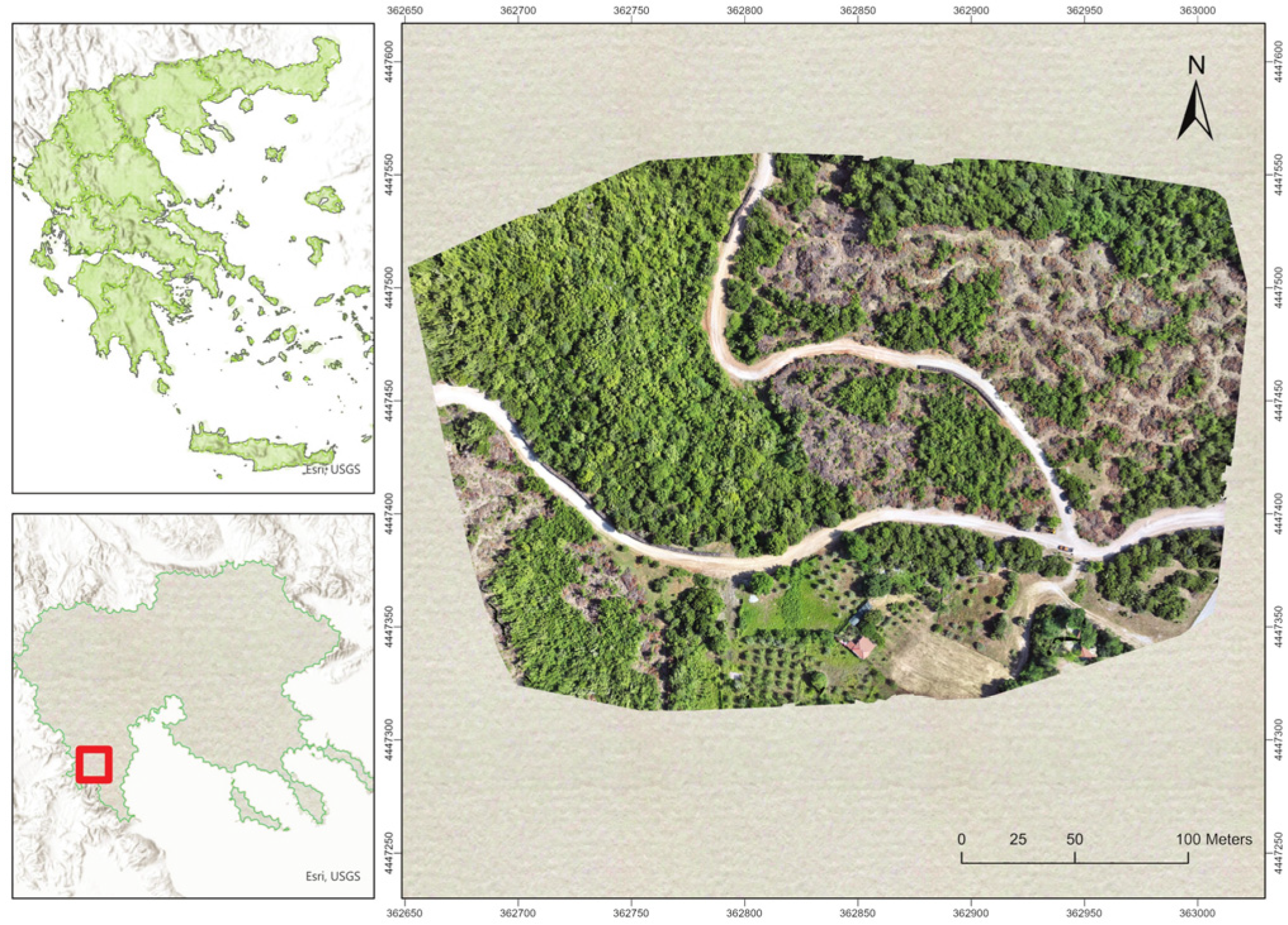
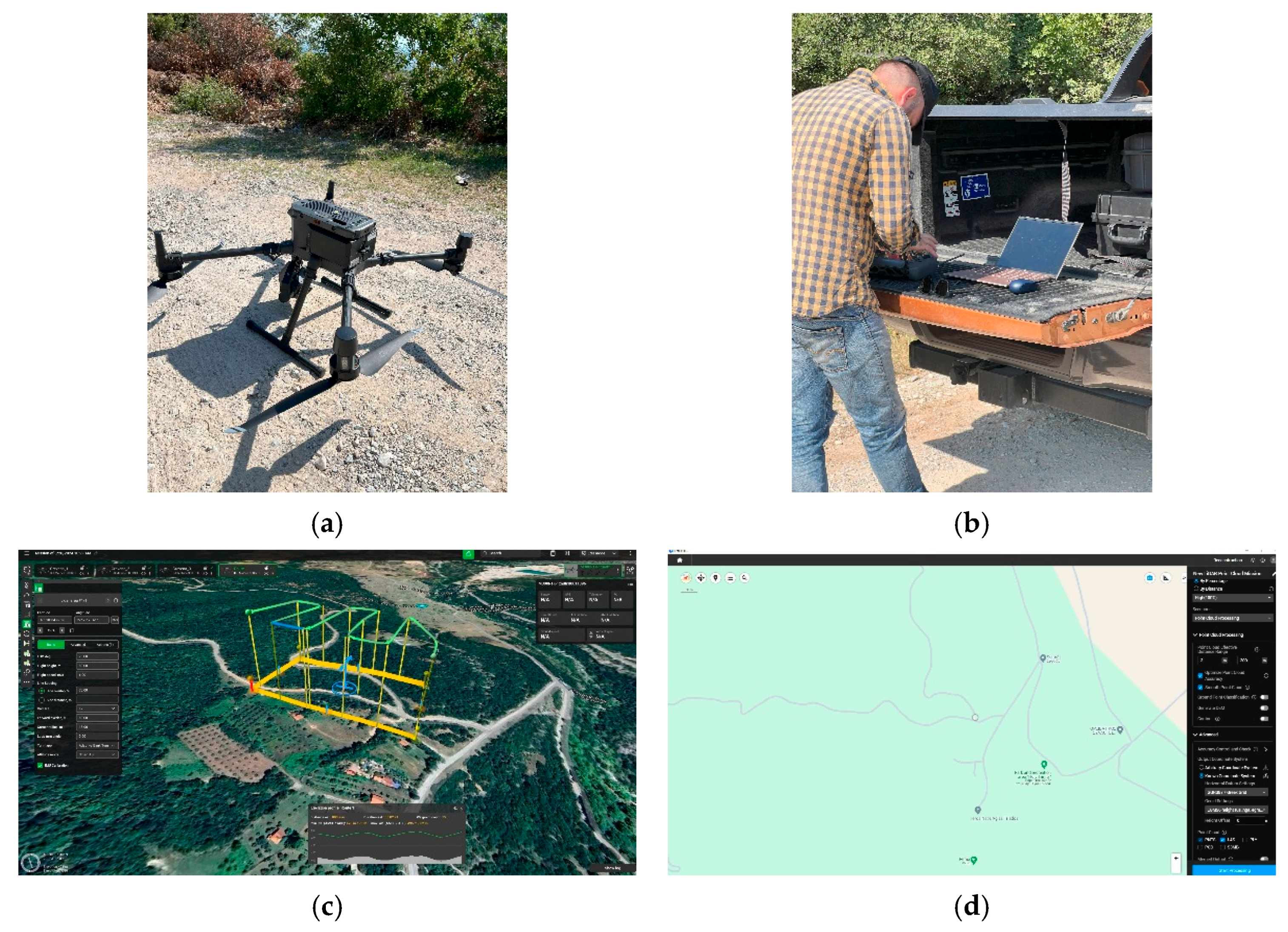
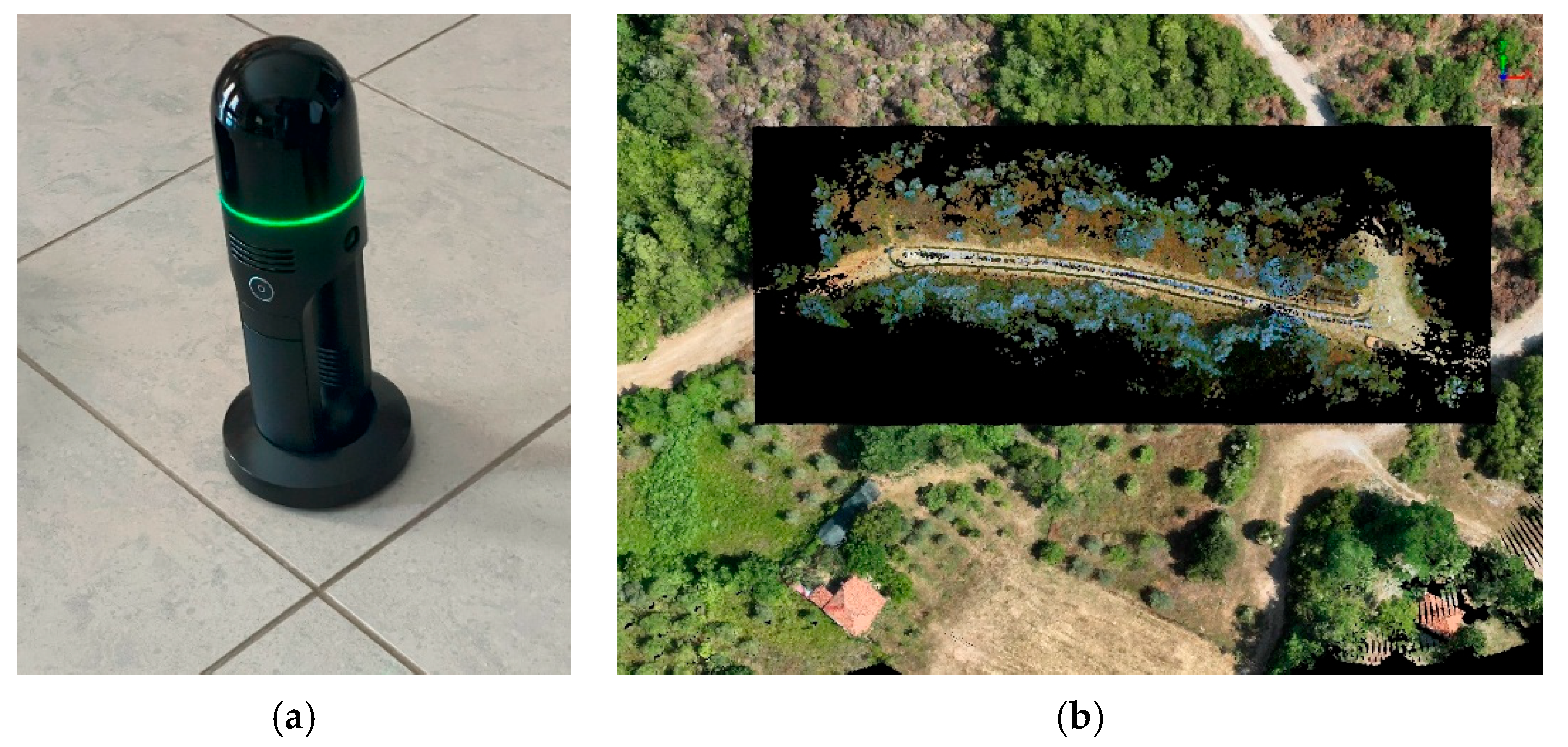
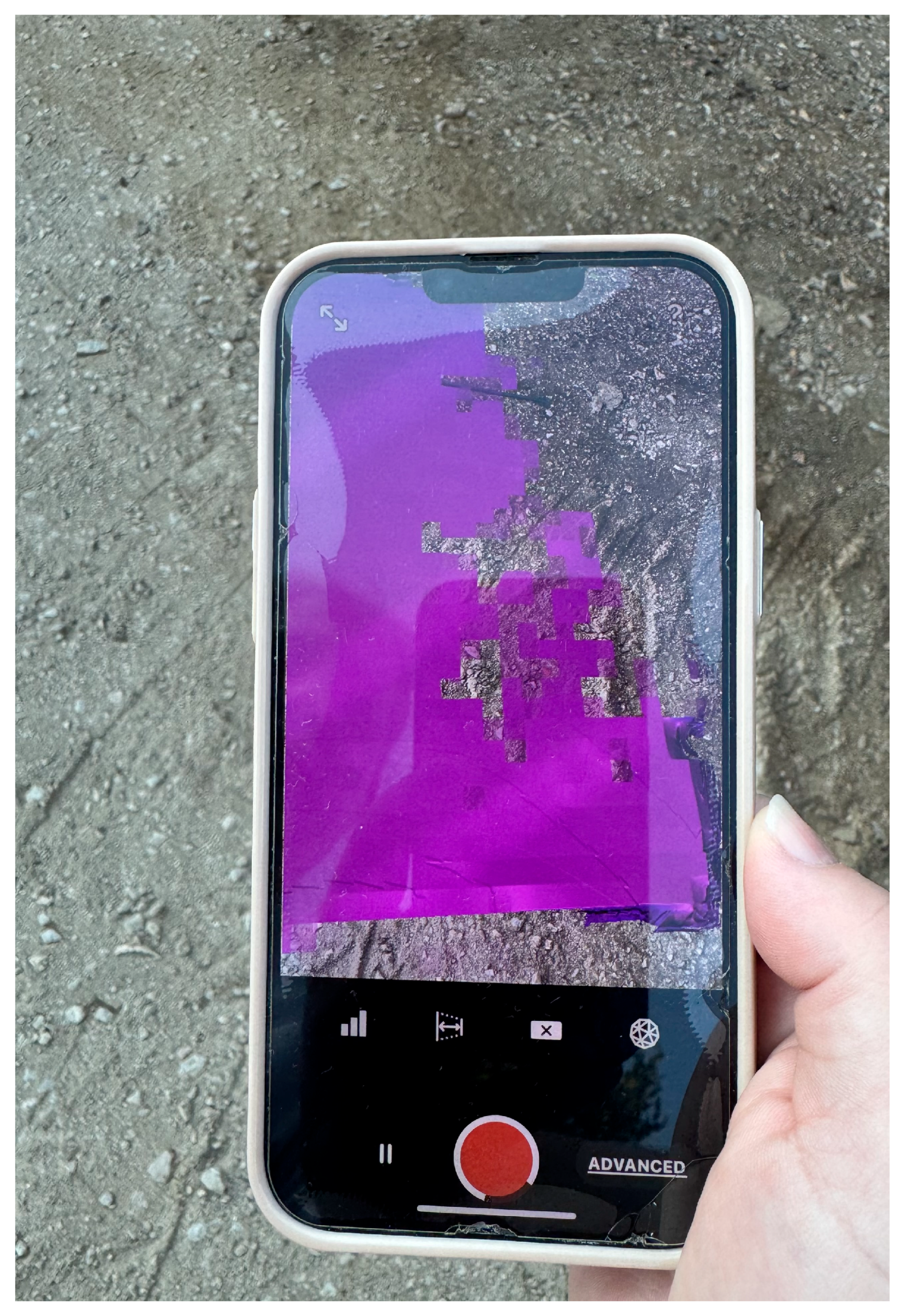




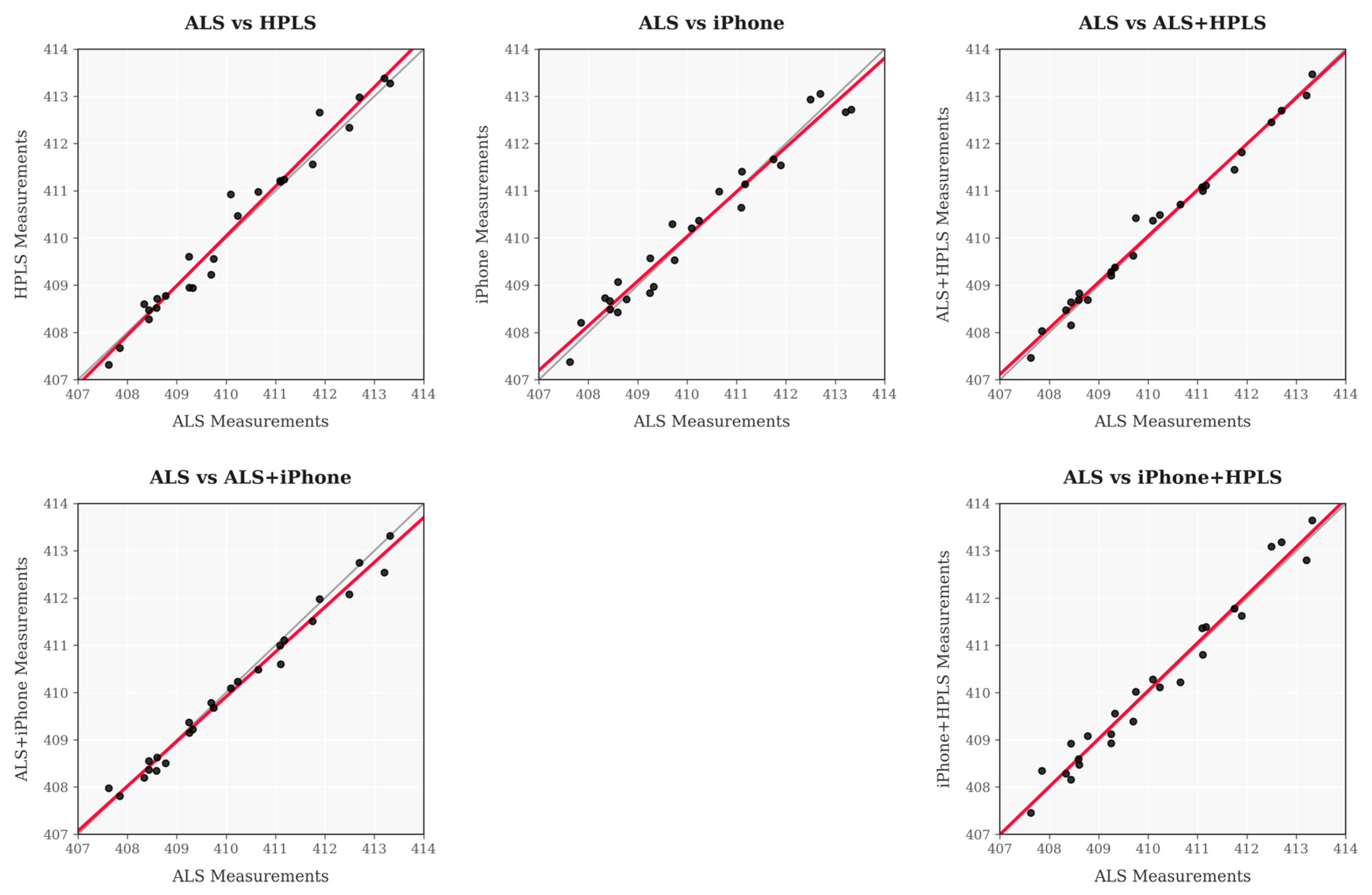
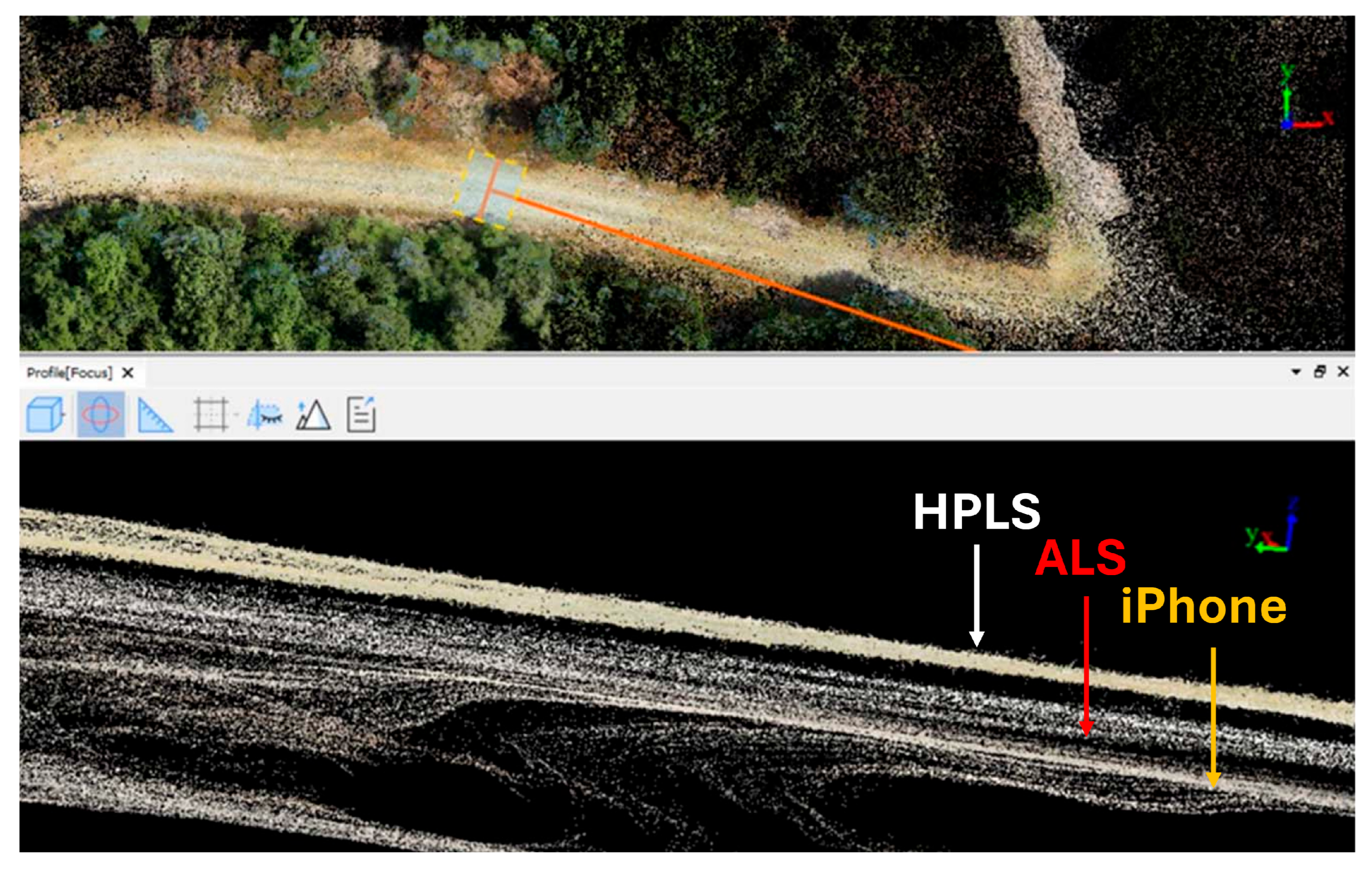

| Road class * | B |
| Type of material | Gravel and soil |
| Construction year | 1994 |
| Year of last maintenance | 2023 |
| Length (m) | 608 |
| Road width (m) | 4–6 |
| Maximum longitudinal downhill slope (%) | 8 |
| Maximum longitudinal uphill slope (%) | 6 |
| Radius of curvature in maneuvers (m) | 20 |
| Average slope (%) | 6 |
| Method | MAE | RMSE | Relative Error (%) |
|---|---|---|---|
| HPLS | 0.507 | 0.542 | 0.123 |
| iPhone | 0.229 | 0.279 | 0.056 |
| ALS + HPLS | 0.346 | 0.487 | 0.084 |
| ALS + iPhone | 0.011 | 0.011 | 0.003 |
| iPhone + HPLS | 0.380 | 0.490 | 0.092 |
| Sensor/Interpolation Method Combination | Mean Correlation | Standard Deviation (m) | Range (m) | Local Variation (m) |
|---|---|---|---|---|
| ALS/IDW-Kriging | 0.7796 | 0.414 | 0.1392 | 0.0107 |
| ALS + HPLS/IDW-Kriging | 0.4378 | 0.0231 | 0.0839 | 0.0093 |
| ALS + iPhone/IDW-Kriging | 0.7194 | 0.0771 | 0.2032 | 0.0131 |
| HPLS/IDW-Kriging | 0.5556 | 0.0243 | 0.0958 | 0.0100 |
| iPhone/IDW | 0.4820 | 0.0076 | 0.0273 | 0.0021 |
| iPhone/Kriging | 0.4875 | 0.0075 | 0.0248 | 0.0021 |
| iPhone + HPLS/IDW-Kriging | 0.7570 | 0.0438 | 0.1532 | 0.0104 |
| Terrain Class | Slope Range | Elevation Measurement Consistency | Calculation Accuracy | Performance Characteristics |
|---|---|---|---|---|
| Flat terrain | 0–1% | High | Very high | Optimal performance |
| Gentle slopes | 1–3% | Good | High | Good performance |
| Moderate slopes | 3–5% | Moderate | Moderate | Requires attention |
| Steep slopes | >5% | Variable | Challenging | Needs special consideration |
| Method | Mean Error (m) | Std Dev (m) | RMSE (m) |
|---|---|---|---|
| ALS/Full area | −0.028 | 0.056 | 0.057 |
| ALS/Forest road | 0.021 | 0.025 | 0.029 |
| ALS + HPLS | 0.028 | 0.020 | 0.032 |
| ALS + iPhone | 0.036 | 0.118 | 0.108 |
| HPLS | 0.119 | 0.163 | 0.179 |
| iPhone | 0.036 | 0.121 | 0.111 |
| iPhone + HPLS | 0.054 | 0.105 | 0.106 |
Disclaimer/Publisher’s Note: The statements, opinions and data contained in all publications are solely those of the individual author(s) and contributor(s) and not of MDPI and/or the editor(s). MDPI and/or the editor(s) disclaim responsibility for any injury to people or property resulting from any ideas, methods, instructions or products referred to in the content. |
© 2025 by the authors. Licensee MDPI, Basel, Switzerland. This article is an open access article distributed under the terms and conditions of the Creative Commons Attribution (CC BY) license (https://creativecommons.org/licenses/by/4.0/).
Share and Cite
Siafali, E.; Polychronos, V.; Tsioras, P.A. Fusion of Airborne, SLAM-Based, and iPhone LiDAR for Accurate Forest Road Mapping in Harvesting Areas. Land 2025, 14, 1553. https://doi.org/10.3390/land14081553
Siafali E, Polychronos V, Tsioras PA. Fusion of Airborne, SLAM-Based, and iPhone LiDAR for Accurate Forest Road Mapping in Harvesting Areas. Land. 2025; 14(8):1553. https://doi.org/10.3390/land14081553
Chicago/Turabian StyleSiafali, Evangelia, Vasilis Polychronos, and Petros A. Tsioras. 2025. "Fusion of Airborne, SLAM-Based, and iPhone LiDAR for Accurate Forest Road Mapping in Harvesting Areas" Land 14, no. 8: 1553. https://doi.org/10.3390/land14081553
APA StyleSiafali, E., Polychronos, V., & Tsioras, P. A. (2025). Fusion of Airborne, SLAM-Based, and iPhone LiDAR for Accurate Forest Road Mapping in Harvesting Areas. Land, 14(8), 1553. https://doi.org/10.3390/land14081553






